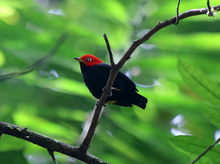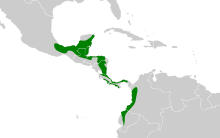| Red-capped manakin | |
|---|---|

| |
| Male | |
| Dixiphia mentalis - Red-capped Manakin | |
| Conservation status | |
 Least Concern (IUCN 3.1) | |
| Scientific classification | |
| Domain: | Eukaryota |
| Kingdom: | Animalia |
| Phylum: | Chordata |
| Class: | Aves |
| Order: | Passeriformes |
| Family: | Pipridae |
| Genus: | Ceratopipra |
| Species: | C. mentalis |
| Binomial name | |
| Ceratopipra mentalis (Sclater, PL, 1857) | |

| |
| Synonyms | |
| |
The red-capped manakin (Ceratopipra mentalis) is a species of bird in the family Pipridae. It is found in Belize, Colombia, Costa Rica, Ecuador, Guatemala, Honduras, Mexico, Nicaragua, Peru and Panama. Its natural habitat is subtropical or tropical moist lowland forest.
The bird is probably best known for the male's unusual courting method whereby he shuffles rapidly backwards across a branch, akin to a speedy moonwalk.
Taxonomy
The red-capped manakin was formally described and illustrated in 1857 by the English zoologist Philip Sclater based on specimen collected by Auguste Sallé in Córdoba, Veracruz, southern Mexico. Sclater placed the species in the genus Pipra and coined the binomial name Pipra mentalis. The specific epithet mentalis is Latin meaning "pertaining to the chin".
The red-capped manakin was moved to the genus Ceratopipra when molecular phylogenetic studies found that Pipra was non-monophyletic. It is closely related to, and in eastern Panama sometimes hybridizes with, the golden-headed manakin.
Three subspecies are recognized subspecies:
- Ceratopipra mentalis mentalis (Sclater, PL, 1857) – southeast Mexico to east Costa Rica
- Ceratopipra mentalis ignifera (Bangs, 1901) – west Costa Rica and west Panama
- Ceratopipra mentalis minor (Hartert, 1898) – east Panama, west Colombia and northwest Ecuador
Description

The red-capped manakin is a small passerine, measuring 4 in (10 cm) in length and weighing 16 g (0.56 oz). The male is velvety black apart from a bright red head and nape, bright yellow thighs, and a pale yellow chin and wing linings. The female is olive green above, with paler, more yellow-green underparts. Both sexes have dull brown legs. The male's irides are white, while those of the female and young are brown.
While the adult male is distinctive, the female and youngsters can be confused with several similar species. The male golden-collared manakin is larger, and has orange (rather than brown) legs, while the female velvety manakin is a brighter green (rather than olive).
Habitat and range
Found primarily in humid forest and second growth woodland, the red-capped manakin typically occurs below 400–500 m (1,300–1,600 ft) above sea level, though it sometimes ranges as high as 900 m (3,000 ft). Most are resident, but some individuals are known to migrate to take advantage of changing food resources: the number of red-capped manakins caught in mist nets at La Selva Biological Reserve, in eastern Costa Rica, tripled in January and February, when a favored fruit ripened, for example, while the number caught at a nearby higher elevation site (where the fruits were not found) dropped to zero.
Behavior
Food and feeding
The red-capped manakin is a frugivore, feeding almost exclusively on fruits. These pass very quickly through the bird's digestive system, typically taking less than 18 minutes to process. The manakins ability to process large quantities of fruit have evolved to be fast due to experiencing certain seasons where there is not an abundant amount of fruits. Therefore, they had to consume large volumes of food to get the nutrients they need. Seeds from a variety of plants are consumed; one study in Costa Rica found evidence of 70 species, including those from the genera Clidemia, Hampea, Henriettea, Leandra, Miconia, Ossaea, Pinzona and Psychotria, in the fecal droppings of red-capped manakins.
Notes
- By convention, length is measured from the tip of the bill to the tip of the tail on a dead bird (or skin) laid on its back.
References
- BirdLife International (2016). "Ceratopipra mentalis". IUCN Red List of Threatened Species. 2016: e.T22700994A93808541. doi:10.2305/IUCN.UK.2016-3.RLTS.T22700994A93808541.en. Retrieved 26 November 2022.
- Sclater, Philip Lutley (1856). "Calatlogue of the birds collected by M. Auguste Sallé in southern Mexico, with descriptions of new species". Proceedings of the Zoological Society of London. Part 24 (319): 283–311 . Although the volume is dated 1856 on the title page, the article was not published until 1857.
- Traylor, Melvin A. Jr, ed. (1979). Check-List of Birds of the World. Vol. 8. Cambridge, Massachusetts: Museum of Comparative Zoology. p. 278.
- Jobling, James A. (2010). The Helm Dictionary of Scientific Bird Names. London: Christopher Helm. p. 250. ISBN 978-1-4081-2501-4.
- Ohlson, J.I.; Fjeldså, J.; Ericson, P.G.P. (2013). "Molecular phylogeny of the manakins (Aves: Passeriformes: Pipridae), with a new classification and the description of a new genus". Molecular Phylogenetics and Evolution. 69 (3): 796–804. doi:10.1016/j.ympev.2013.06.024. PMID 23831559.
- ^ Gill, Frank; Donsker, David; Rasmussen, Pamela, eds. (July 2020). "Cotingas, manakins, tityras, becards". IOC World Bird List Version 10.2. International Ornithologists' Union. Retrieved 15 December 2020.
- ^ Hilty, Steven (1986). A Guide to the Birds of Colombia. Princeton, NJ: Princeton University Press. p. 430. ISBN 0-691-08372-X.
- ^ Stiles, F. Gary; Skutch, Alexander F (1989). A Guide to the Birds of Costa Rica. Cornell University Press. pp. 299–300. ISBN 0-8014-9600-4.
- Cramp, Stanley, ed. (1977). Handbook of the Birds of Europe, the Middle East and North Africa: Birds of the Western Palearctic, Volume 1, Ostrich to Ducks. Oxford University Press. p. 3. ISBN 0-19-857358-8.
- Hilty, Steven L.; Wolf, Mimi Hoppe (2005). Birds of Tropical America: A Watcher's Introduction to Behavior, Breeding, and Diversity. University of Texas Press. pp. 89–90. ISBN 0-292-70673-1.
- Bucher, Theresa L.; Worthington, Andrea (May–June 1982). "Nocturnal Hypothermia and Oxygen Consumption in Manakins" (PDF). The Condor. 84 (3): 327–331. doi:10.2307/1367377. JSTOR 1367377.
- Worthington, Andrea (1989). "Adaptations for Avian Frugivory: Assimilation Efficiency and Gut Transit Time of Manacus vitellinus and Pipra mentalis". Oecologia. 80 (3): 381-389. Retrieved 4 November 2024.
- Loiselle, Bette A.; Blendinger, Pedro G.; Blake, John G.; Ryder, Thomas B. (2007). "Ecological Redundancy in Seed Dispersal Systems: A Comparison Between Manakins (Aves Pipridae) in Two Tropical Forests". In Dennis, Andrew J; Schupp, Eugene W; Green, Ronda J.; Westcott, David A (eds.). Seed dispersal: theory and its application in a changing world. Wallingford, UK: CABI. p. 184. ISBN 978-1-84593-165-0.
Further reading
- Skutch, Alexander F. (1969). "Yellow-thighed manakin" (PDF). Life Histories of Central American Birds III: Families Cotingidae, Pipridae, Formicariidae, Furnariidae, Dendrocolaptidae, and Picidae. Pacific Coast Avifauna, Number 35. Berkeley, California: Cooper Ornithological Society. pp. 110–117.
External links
| Taxon identifiers | |
|---|---|
| Ceratopipra mentalis |
|
| Pipra mentalis | |